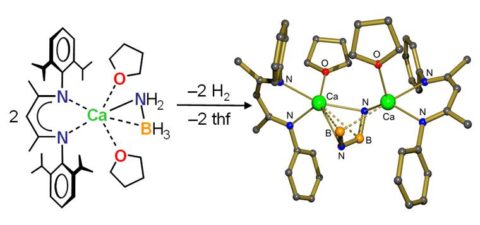Hydrogen Storage Materials
Ammonia-Borane (NH3BH3) is one of the most promising materials for chemical storage of H2. It contains nearly 20 wt% of H, is non-toxic and non-flammable. Decomposition into H2 and “BN” materials, however needs forcing conditions (120-500 °C) and is non-reversible.
Recently introduced metal-amidoborane storage materials, LiNH2BH3 or Ca(NH2BH3)2, show numerous advantages. H2-release takes place at lower temperatures (90-200 °C) and is nearly thermoneutral which facilitates the search for reversibility.
Research on these materials has mainly been done in the solid state which makes characterization of decomposition products and mechanistic research difficult.
We prepared the first molecular metal amidoborane complexes that are soluble in organic solvents and therefore can be studied by NMR and X-ray diffraction. These molecules loose H2 already at the record-low temperature of 20 °C. More important, the molecular approach allows for studies on the decomposition products of which several have been structurally characterized. This led to the observation of new BN-species that play a prominent role in the decomposition mechanism. Influences of metals and substituents have also been investigated.
(Spielmann, Jansen, Bandmann, Harder Angew. Chem. 2008)
(Spielmann, Harder et al. J. Am. Chem. Soc. 2009)
(Harder et al. Chem. Commun. 2009)
(Spielmann, Bolte, Harder Chem. Commun. 2009)
(Spielmann, Piesik, Harder Chem. Eur. J. 2010)
